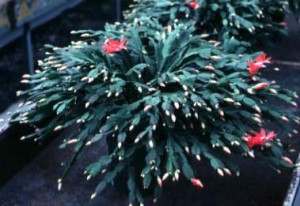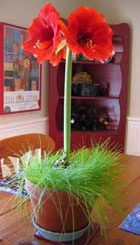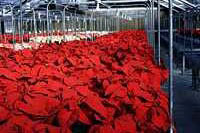With the holidays rapidly approaching, it is a great time to give the gift of a blooming plant that can be used to decorate the home. Here are some tips to keep your plant healthy, happy and ready to bloom.
Christmas cactus and Amaryllis are plants native to Central and South America while Poinsettia comes from Mexico. Since these are all tropical plants, they share a lot of basic “do’s and don’ts.”
- Do keep plants in windows with bright, indirect lighting.
- Do provide room temperatures between 65-70°. If you’re comfortable, so is the plant. Cool temperatures will help it keep the blossoms longer.
- Do water when the top 1” of soil feels dry to the touch, but don’t let your plant sit in standing water.
- Do fertilize with a balanced, all-purpose liquid fertilizer only after your plant has finished blooming.
- Don’t place your plant near cold drafts or excessive heat. If you’re going to transport the plants, place them in a large shopping bag or box to protect them from the cold.
 CHRISTMAS CACTUS (Schlumbergera bridgesii): Known as epiphytes (a plant that grows on another plant), the Christmas cactus is found growing on decayed leaves and debris in the forks of tree limbs the same way orchids grow. [Ed. Note: There is also the Easter cactus (S. gaertneri) and the Thanksgiving cactus (S. truncata)].
CHRISTMAS CACTUS (Schlumbergera bridgesii): Known as epiphytes (a plant that grows on another plant), the Christmas cactus is found growing on decayed leaves and debris in the forks of tree limbs the same way orchids grow. [Ed. Note: There is also the Easter cactus (S. gaertneri) and the Thanksgiving cactus (S. truncata)].
These plants love humidity so a good idea is to put gravel in the pot’s saucer. Excess water will drain into the gravel and give your cactus the moisture it loves.
Feed your cactus with a 0-10-10 liquid fertilizer in February when it has finished blooming. From April through September you can use a liquid 10-10-10 monthly. In late October or early November, feed it once more with the liquid 0-10-10.
When summer arrives, you may want to move your cactus outdoors. If you do, keep it in a partial to total shade location. Too much direct sunlight can burn the leaves. To propagate and encourage your plant to branch out, prune it after blooming. Remove a few sections from each stem by finger pinching or cutting with a knife and root these sections in moist vermiculite or sand. Once rooted, transplant to a potting mixture for succulents or combine two parts potting soil with one part sand or vermiculite.
Christmas Cactus Reblooming Tips: About September 1st bring your plant back indoors and keep the room temperature around 50°F. Place it where it will receive bright, indirect light during the daylight hours and total darkness at night. During the fall and winter months, water it less frequently to promote blooming.
Problem Note: Buds dropping off of your plant can be the result of over-watering, insufficient light, or lack of humidity.
AMARYLLIS (Hippeastrum spp.):
 If you’ve received this wonderful bulb that was not potted, soak the roots of the bulb in lukewarm water for an hour. Plant the bulbs in a well-drained potting mix with the soil up to the base of the bulb’s neck and firm the soil to set the bulb in place. The potted bulb needs to be placed in warm location with direct light to encourage stem development. The warmer the temperature (70-80°), the faster it will sprout and grow. Water it sparing until the bud and leaves appear; then gradually increase the amount of water it receives. Be sure to rotate the pot so the plant will grow straight. A south facing window provides ample sunshine to help the stem’s rapid growth. As soon as it reaches its full height,
If you’ve received this wonderful bulb that was not potted, soak the roots of the bulb in lukewarm water for an hour. Plant the bulbs in a well-drained potting mix with the soil up to the base of the bulb’s neck and firm the soil to set the bulb in place. The potted bulb needs to be placed in warm location with direct light to encourage stem development. The warmer the temperature (70-80°), the faster it will sprout and grow. Water it sparing until the bud and leaves appear; then gradually increase the amount of water it receives. Be sure to rotate the pot so the plant will grow straight. A south facing window provides ample sunshine to help the stem’s rapid growth. As soon as it reaches its full height,
flowers will develop.
To keep the plant looking its best, pinch off any blossoms that start to droop or wither. After flowering, cut off the stalks so that only 2”-4” remain. Put the pot in a warm, sunny spot and continue to water when the soil feels dry. You can move your amaryllis outdoors in full or partial sun when the temperature in spring has warmed up. A monthly liquid fertilizer 10-10-10 is recommended for the next 5-6 months.
Amaryllis Reblooming Tips: As cold weather approaches, stop watering and feeding your plant to force it into dormancy. Remove any foliage that turns yellow or is dead. Before the first frost, bring your potted plant indoors and keep it in a cool (50-60°), dry, dark place like your basement. Or you can remove the bulb from the pot, clean off the dirt, and separate any bulblets from the mother bulb. Place all of these in the crisper of the refrigerator for a minimum of 6 weeks.
Problem Note: Don’t store the bulbs in the refrigerator with apples since this will make the bulbs sterile. In November, pot the refrigerated bulbs or remove the potted plant from the basement. Resume your normal care of watering and feeding. There’s a chance your amaryllis won’t bloom the first year, but don’t despair. Give it a second chance.
POINSETTIA (Euphorbia pulcherrima):
 Our first Ambassador to Mexico, Joel Robert Poinsett, brought these Mexican beauties to the US in 1825. What look like flowers are actually colorful modified leaves (bracts). The true flower is a small green or yellow nub in the center of the bracts.
Our first Ambassador to Mexico, Joel Robert Poinsett, brought these Mexican beauties to the US in 1825. What look like flowers are actually colorful modified leaves (bracts). The true flower is a small green or yellow nub in the center of the bracts.
These plants definitely won’t tolerate moisture extremes. Too wet and you’ll get root rot. Too dry and it will wilt and drop its leaves. In early April, cut your poinsettia back to 6”-8” in height and place it outdoors in the shade. When new growth appears, keep it watered and fertilized. If you need to transplant your poinsettia to a larger pot, do it in May. Pinch off the growing tips every 4-6 weeks during the summer to make your plant bushy. Do not prune after September 1. Bring your poinsettia indoors before the threat of cold weather.
Poinsettia Reblooming Tips: This can be really tricky and challenging. Beginning around October 1st, place your plant each day in complete darkness from about 5 PM to 8 AM. Do not expose it to even a single burst of light during these dark, nighttime periods. During the daylight hours, place it where it will receive bright, indirect sunlight. By December, you’ll be rewarded with lovely, colorful bracts.
